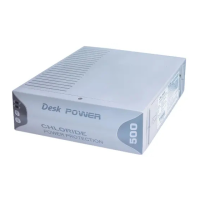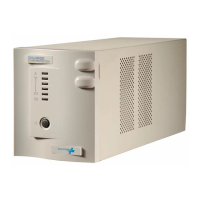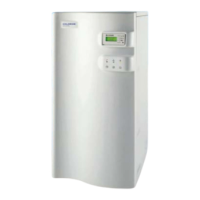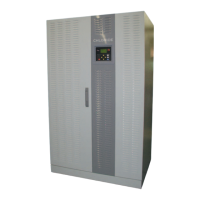Do you have a question about the Chloride Power Protection Active 3000 and is the answer not in the manual?
Specifies the intended purpose of the unit for connected loads in an office environment.
Provides paramount safety importance, review procedures before work, and adherence.
Highlights critical safety notices to prevent danger to life, health, unit reliability, and data security.
Details safety precautions for handling batteries, including electrolyte hazards and high short circuit currents.
Discusses battery disposal and unit disposal in accordance with legislation and environmental impact.
Lists conformity with European directives and standards for electrical equipment.
Provides instructions on how to pack the unit for movement, including acclimatization and material use.
Provides information on installation, operation, and use of the UPS, recommending consultation before installation.
Presents an overview of different UPS unit versions based on housing and nominal power.
Explains the meaning of ATTENTION, WARNING, and NOTE symbols used in the manual.
Mentions that instructions can be supplemented with additional sheets for specific extensions or options.
Instructions for checking packaging and contents upon receipt and reporting any damage or missing parts.
Advises care when unpacking to avoid damage and to check all packaging materials.
Lists the items included in the packaging for Tower units (UPS) and Battery Packs.
Lists items included for Tower UPS units.
Lists items included for Tower Battery Packs.
Lists items included for Rack/Tower UPS units.
Lists items included for Rack/Tower Battery Packs.
Provides guidelines for storing the UPS, including environmental conditions and temperature limits.
Advises on proper handling of the UPS to prevent damage from dropping or impact.
Specifies installation requirements like vertical/horizontal placement, level surface, and environmental protection.
Addresses the importance of floor capacity to support the weight of UPS and battery packs.
Highlights the need for rack cabinets to support the weight of RT models.
Specifies minimum space requirements for air flow and access for electrical maintenance.
Provides installation specifications like ambient temperature, humidity, altitude, and connection points.
Details the process of rack-mounting UPS and battery packs, including safety precautions.
Covers floor standing installation for RT UPS and battery packs as an alternative to rack mounting.
Step-by-step guide for assembling feet and placing the UPS for floor mounting.
Instructions for assembling feet with spacers and placing UPS and battery pack for floor mounting.
Explains the on-line double conversion principle and how the UPS operates in different modes.
Describes the UPS operation when connected to AC input power and supplying the load.
Explains how the UPS operates during a mains failure, using battery power for uninterrupted supply.
Details the UPS operation when the load is supplied directly from AC mains via the internal bypass.
Explains the high-efficiency ECO mode where output is fed directly from input via bypass.
Describes the UPS's capability to operate as a frequency converter, providing fixed output frequency.
Covers additional functionalities like Green Power, Cold Start, Auto-Restart, and wiring fault detection.
Presents a functional block diagram illustrating the internal components and signal flow of the UPS.
Details the front panel switches and LEDs that indicate UPS status and operational modes.
Describes the front panel layout and elements for UPS units equipped with LED indicators.
Lists and describes the function of each switch and LED on the front panel.
Explains the functions and operations of the buttons and LEDs on the front panel.
Describes visual and acoustic indications for various UPS conditions and faults.
Details front panel with LCD display, including its indicators and buttons for operation.
Explains the functions available within the UPS menu structure and sub-menus.
Lists and describes display messages for various warning and fault conditions.
Illustrates the rear panel connections and components for Tower units.
Details the rear panel layout and components of the Active 700 T model.
Shows rear panel layouts for Rack/Tower models like 1000 RT, 1500 RT, 2000 RT, and 3000 RT.
Covers electrical preparations, connections, and startup procedures for the UPS.
Details precautions for connecting input wiring, voltage, and current requirements for the UPS.
Outlines input, output, and battery power connection procedures.
Provides steps for connecting external battery packs, including breaker settings and extension cables.
Explains how to connect input power cords and loads to the UPS.
Guides the user through the initial startup process for the UPS.
Details the steps for the first-time startup of the UPS with LED or LCD display.
Explains the normal startup process for UPS units with LED or LCD displays.
Describes how to place the UPS into bypass mode using front panel buttons or menu options.
Outlines the procedure to enable or disable the ECO mode via the UPS menu.
Details how to activate and deactivate the frequency converter mode using the UPS menu.
Explains how to shut down the UPS by switching off the inverter and disconnecting power.
Describes the external connections for remote power off and on/off functionalities.
Details the available serial interfaces (RS232 DB9 port and USB port) for communication.
Describes the pin configuration and signals of the 9-pole SUB-D connector for RS232.
Explains the functionality of the USB port for protocol-data transfer, classified as HID.
Describes the interface slot for optional cards like SNMP or volt-free contacts.
Provides instructions on how to clean the UPS, including what not to use and how to clean air vents.
Advises on proper storage of the UPS, including battery charging and temperature considerations.
Explains that the UPS performs automatic battery self-tests and how to change the test frequency.
Warns that the load is not protected during battery replacement and discusses internal battery replacement.
Details precautions and procedures for replacing internal UPS batteries by knowledgeable personnel.
Guides on proper disposal of used batteries and classification as hazardous waste.
Provides instructions for qualified technicians to replace the front panel with an LCD display.
Lists common problems, their possible causes, and corrective actions for UPS issues.
Provides detailed technical specifications for various UPS models.
Lists technical specifications for different UPS ratings and housing types.
Details technical specifications for different battery pack models.
Presents theoretical runtime values for various UPS models with different loads and battery configurations.
| Real Power | 2700 W |
|---|---|
| Output Power Factor | 0.9 |
| Humidity | 0-95% non-condensing |
| Power Rating | 3000 VA |
| Input Voltage | 230 VAC |
| Input Voltage Range | 160-276 V |
| Output Voltage | 230 VAC |
| Frequency Range | 50/60 Hz |
| Battery Type | Sealed Lead-Acid (SLA) |
| Typical Recharge Time | 4 hours |
| Runtime at Full Load | 5 minutes |
| Communication Interface | USB, RS232 |
| Operating Temperature | 0°C to 40°C |
| Storage Temperature | -15°C to 45°C |



